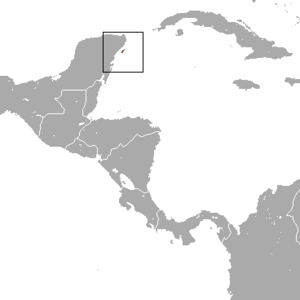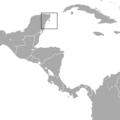Cozumel thrasher facts for kids
Quick facts for kids Cozumel thrasher |
|
|---|---|
| Conservation status | |
| Scientific classification | |
| Genus: |
Toxostoma
|
| Species: |
guttatum
|
 |
|
| Cozumel thrasher range | |
The Cozumel thrasher (Toxostoma guttatum) is a special bird that lives only on Cozumel Island, off the Yucatán Peninsula in Mexico. It's part of the mockingbird family. This bird is thought to be the most endangered bird in Mexico. Scientists are not completely sure if it still exists, but they have hope!
The Cozumel thrasher is related to the long-billed thrasher and brown thrasher. People have described it as shy, but some say it's not. This bird used to be common all over Cozumel. However, two big hurricanes greatly reduced its numbers. Also, invasive species (animals or plants brought to an area where they don't naturally belong) might have hurt the thrasher population.
Contents
About the Cozumel Thrasher
How it was Discovered
The Cozumel thrasher was first described by a scientist named Robert Ridgway in 1885. At first, some thought it was just a type of long-billed thrasher. But a study in 1998 showed that it was different enough to be its own species. This bird is unique and doesn't have any subspecies.
What it Looks Like
The Cozumel thrasher is about 21.5 to 24 centimeters (8.5 to 9.5 inches) long.
- Its head, back, and shoulders are brown.
- Its lower back and rump have a reddish-brown color.
- Its wings are warm brown with black bars and hidden white tips.
- The main flight feathers are grayish-brown with reddish-brown edges.
- Its tail feathers are also a warm brown.
- The area around its eyes and ears is mottled grey-brown.
- Its chin and throat are off-white.
- It has a black stripe on its cheek.
- The chest is buffy-white with clear black teardrop-shaped spots.
- Its belly is off-white, and its sides have larger black spots.
- The underside of its wings is buffy-white with darker marks.
- It has yellow eyes, a grayish-brown beak, and dull brown legs.
Young thrashers likely look similar to adults, just like their relatives.
Similar Birds
The Cozumel thrasher looks a bit like the long-billed thrasher. However, the Cozumel thrasher is smaller (26.5 to 29 cm for the long-billed), darker, has a blacker beak, and its spots are clearer. No other thrasher lives on Cozumel Island. But people might confuse it with the wood thrush, which visits the island. The wood thrush has a shorter beak and no wing bars.
Where it Lives
The Cozumel thrasher lives only on Isla Cozumel. This island is about 45 kilometers (28 miles) long and 20 kilometers (12 miles) wide.
These birds seem to prefer living in low and medium-sized forests. These forests can be deciduous (trees lose leaves) or semi-deciduous. They might have been most common near the edges of forests, close to open areas.
How it Behaves
The Cozumel thrasher mostly stays on the ground. It is known to be hard to spot. Like other thrashers in its group, it might run away instead of flying when it gets scared. Some scientists have noted its secretive behavior, while others haven't.
Its song is described as a rich, varied warble. It can sound a little scratchy and doesn't repeat much. Its alarm call is similar to the brown thrasher's.
Why it's Endangered
The number of Cozumel thrashers dropped very quickly after Hurricane Gilbert hit the island on September 14, 1988. After that, it was last seen in 1995. That same year, Hurricane Roxanne hit Cozumel on October 11. Many people thought the bird had become extinct (died out completely).
However, the bird was seen again in June 2004! It's still not clear how much damage Hurricanes Emily and Wilma caused in 2005. A survey in December 2006 did not find the bird.
Local people have suggested that the bird might be found near the Mayan ruins of San Gervasio.
The last possible sightings were in April 2006 at the Cozumel Golf Club. More thrashers were seen in October and December 2007, but scientists couldn't be sure if they were Cozumel thrashers. Efforts to find the bird continue. Even though a few birds seem to be alive, scientists had not officially confirmed the species' survival as of January 2008.
Some scientists believe that other things must have also caused the bird's decline. Cozumel thrashers likely survived hurricanes for thousands of years. Introduced species might be a problem. For example, boa constrictor snakes were brought to the island in 1971 and are now common. These snakes might be harming the thrasher population.
Images for kids
See also
 In Spanish: Cuitlacoche de Cozumel para niños
In Spanish: Cuitlacoche de Cozumel para niños



